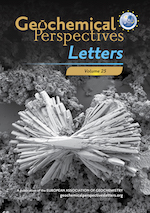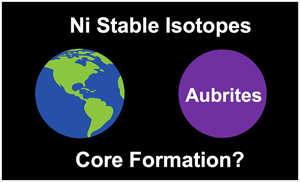 | Planetary accretion and core formation inferred from Ni isotopes in enstatite meteorites Abstract: Nickel is a siderophile and near-refractory element, making its isotopes a potential tool for tracing planetary accretion and differentiation. However, the origin of the Ni stable isotope difference between bulk silicate Earth (BSE) and chondrites remains enigmatic. To address this problem, we report high precision Ni stable isotope data of enstatite chondrites and achondrites that possess similar mass independent O and Ni isotope compositions like the Earth-Moon system. Bulk enstatite chondrites have δ60/58Ni values of 0.24 ± 0.08 ‰ (2 s.d., n = 13). Enstatite achondrites, including main-group aubrites, Shallowater and Itqiy, show relatively large δ60/58Ni variations, ranging from 0.03 ± 0.02 ‰ to 0.57 ± 0.04 ‰. This could reflect fractionations between sulfide and metal phases, as is evidenced by correlation between their S/Ni ratios and δ60/58Ni values. In enstatite achondrites, Ni is mainly hosted in metal and to a lesser extent in sulfides, so δ60/58Ni values in enstatite achondrites may represent the Ni isotopic values of the cores of their parent bodies. The overlapping δ60/58Ni values between bulk enstatite achondrites and enstatite chondrites indicate limited Ni stable isotope fractionation during core formation processes on reduced, sulfur-rich parent bodies. The Ni stable isotope gap between chondrites and the BSE could be possibly explained by chondrule-rich accretion model. |
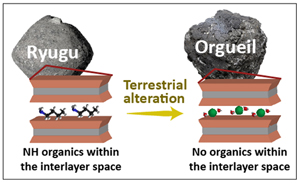 | Interaction between clay minerals and organics in asteroid Ryugu Abstract: The Hayabusa 2 spacecraft brought back to Earth grains of the carbonaceous asteroid Ryugu. Such grains represent the pristine state of CI chondritic materials and have been preserved from exposure to Earth’s atmosphere. Here, we show evidence of the presence of organics trapped within the interlayer space of smectite layers in Ryugu grains. No such organics are found in the Orgueil CI meteorite. We put forward that the organics within the interlayer space of smectite in Orgueil CI meteorite were lost during their oxidation on Earth. Also, we propose that the presence of organics within the interlayers space of smectite might be responsible for the possible NH infrared signature observed in Ryugu particles and potentially to a few large C-type asteroids including Ceres. |
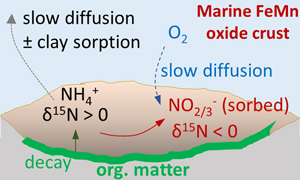 | An isotopically light nitrogen reservoir in the ocean: evidence from ferromanganese crusts Abstract: Ferromanganese (FeMn) oxide crusts and nodules in the deep ocean have been studied extensively in the context of critical metals and metal isotope mass balances; however, their role in the marine nitrogen cycle has been unexplored. Here we investigated a suite of hydrogenetic and diagenetic marine FeMn crusts and nodules from the Pacific to determine their isotopic signature and contribution as another N sink from the modern ocean. Our results reveal unusually low δ15N values down to −12 ‰ in some hydrogenetic crusts, paired with low δ13C values in carbonate associated with these crusts and nodules. This pattern is most parsimoniously explained by partial oxidation of ammonium (nitrification) derived from benthic biomass. Nitrification generates isotopically light nitrite, which may adhere to FeMn oxides by adsorption. In contrast, the diagenetic and hydrogenetic nodules are enriched in 15N/14N to up to +12 ‰, likely due to retention of ammonium in phyllosilicate minerals. Overall, we conclude that FeMn oxide crusts and nodules are a novel archive of microbial activity that may be preserved in the sedimentary record on Earth and possibly Mars. |
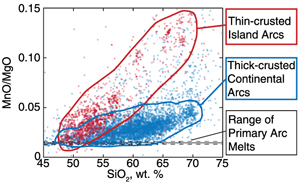 | MnO/MgO ratios of arc basalts highlight the role of early garnet fractionation Abstract: Multiple lines of evidence suggest that garnet may play an important role in the generation of arc magmas, either as a residual phase during mantle melting or subsequently during crystallisation differentiation. Moreover, garnet stability is strongly pressure sensitive, and therefore garnet fractionation can serve as an indirect indicator of fractionation pressure. Here, we introduce MnO/MgO ratios as a compositional proxy uniquely sensitive to garnet fractionation. We show that primary mantle melts have nearly invariant MnO/MgO ratios that are in equilibrium with mantle olivine. Therefore, the subsequent evolution of this ratio is only a function of magmatic differentiation. Further, based on compiled experimental studies, garnet is the only phase that crystallises from basaltic magmas and preferentially partitions MnO relative to MgO. Thus, limited increases in MnO/MgO ratios during magmatic differentiation, as we observe in most continental arcs, are strong evidence for early garnet fractionation and require that crystallisation differentiation begins at or below the Moho of many arcs. |
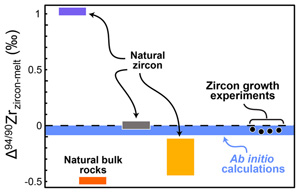 | Zircon growth experiments reveal limited equilibrium Zr isotope fractionation in magmas Abstract: Recent studies of zirconium isotopes in igneous systems have revealed significant mass dependent variability, the origin of which remains intensely debated. While magmatic zircon crystallisation could potentially drive equilibrium isotope fractionation, given that Zr4+ undergoes a shift in coordination as zircon precipitates from a silicic melt, ab initio calculations predict only limited equilibrium fractionation between zircon and melt at magmatic temperatures. To resolve this debate, we determined the isotopic fractionation between co-existing zircon and silicic melt using controlled zircon growth experiments. Our experimental results indicate that zircon has a lower δ94/90Zr relative to co-existing melt by ∼0.045 ‰ at magmatic conditions, which is in excellent agreement with ab initio predictions. Our results imply that, for most natural systems studied to date, the observed variability is predominantly a result of non-equilibrium rather than equilibrium isotope fractionation during zircon crystallisation. |
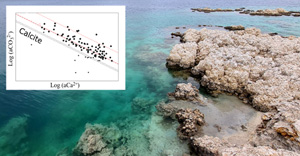 | The chemical conditions necessary for the formation of microbialites Abstract: Whether biological and/or physico-chemical variations may have changed the abundance of microbialites over geological times remains debated. This calls for a better appraisal of the conditions necessary for the formation of modern microbialites. Here, we compiled datasets from 140 aqueous environments where modern microbialites have been reported, including their respective physico-chemical parameters. By analysing this database, we find that solutions where microbialites form have a relatively high saturation with calcite, the chemical activities of Ca2+ and CO32− being controlled by the solubility of amorphous calcium carbonate (ACC) or monohydrocalcite (MHC) in most of these localities. Further statistical analyses of two databases listing ∼8000 continental aqueous systems show that only a few of them display saturation with ACC/MHC, appearing as candidates for the detection of overlooked microbialites. |
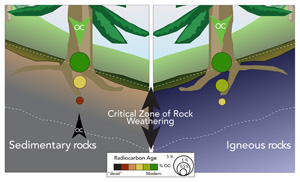 | Global patterns of radiocarbon depletion in subsoil linked to rock-derived organic carbon Abstract: Organic matter stored in sedimentary rocks is one of the largest stocks of carbon at Earth’s surface. The fate of this rock organic carbon (OCpetro) during weathering in soils influences the geological carbon cycle, and impacts soil radiocarbon content that is used to quantify soil carbon turnover. Here, we assess the potential contribution of OCpetro to soils, using a mixing model generated by a global dataset of soil radiocarbon measurements (14C). Soils developed on sedimentary rocks (rather than on igneous substrate) have a paired OC content and 14C values consistent with OCpetro input, giving rise to apparent increase in soil residence time. We call for renewed assessment of OCpetro input to soils, in terms of its impact on soil radiocarbon inventories, and its potential to release carbon dioxide. |
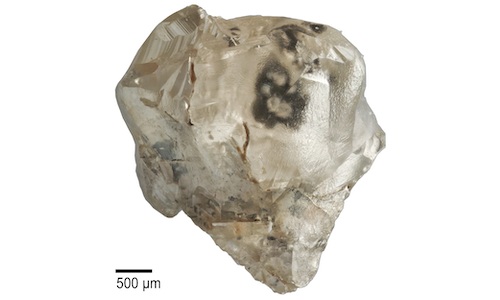 | Geobarometric evidence for a LM/TZ origin of CaSiO3 in a sublithospheric diamond Abstract: Breyite is the second most abundant mineral inclusion in super-deep diamonds after ferropericlase. Though breyite stability extends to 300 km along typical mantle geotherm, this phase is often assumed to be the product of retrograde transformation of CaSiO3-perovskite, and thus has the potential to retain information from as deep as 800–1000 km. In this study, we determined the depth of formation of a breyite inclusion still enclosed in its host diamond from Juîna, Brazil, by X-ray diffraction. The measured >5 % smaller unit cell for breyite indicates a stored residual pressure showing that the breyite was entrapped between about 9(1) and 10(1) GPa. These are the highest estimates of formation pressure ever determined for a breyite inclusion. For ambient mantle temperatures higher than 1400–1500 °C, these pressures would exceed the maximum P of the breyite stability field. Breyite in this diamond cannot be primary but is rather a back-transformation product from CaSiO3-perovskite formed in the transition zone or the lower mantle. The co-existence magnesite in diamond JU55 and the slab-association of sublithospheric diamonds is evidence of carbon transport to lower mantle depths. |
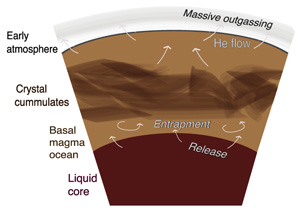 | The magma ocean was a huge helium reservoir in the early Earth Abstract: Helium from mantle-derived rocks bears in its isotopic ratios the traces of Earth differentiation, degassing, and long term geodynamic evolution. The low 4He/3He ratio of rocks whose origins are in the deep mantle, like ocean island basalts (OIBs), reflect potentially concealed geochemical reservoirs rich in primordial 3He and isolated from the surface. Here we search for the geological repository of primordial He lasting from the core formation. For this, we determine the chemical behaviour of He in the magma ocean (MO) during core formation. We perform ab initio molecular dynamics simulations at temperatures and pressures along the MO adiabat. Our results show that primordial He was largely trapped in MO. At the top, under the hot dense early atmosphere, He remained mainly in the MO and degassed only later, at low atmospheric pressure. At the bottom, He partitions preferentially into the MO rather than the liquid core. The origin of the OIBs reflects a large contribution and contamination from mantle sources and no contribution from the top of the outer core, depleted in primordial He. We suggest the search for the He reservoirs should be done at the base of the solid mantle. |
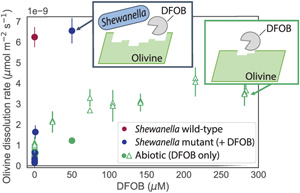 | Bacterial use of siderophores increases olivine dissolution rates by nearly an order of magnitude Abstract: Mafic minerals, such as olivine, are an important source of metals and alkalinity to Earth’s surface, impacting the planet’s long term carbon cycle and climate. Yet, environmental controls on their dissolution rates remain poorly understood. Recent studies show that exogenous siderophores can enhance olivine dissolution abiotically, but it remains unclear how important siderophores are in microbially enhanced dissolution. Here, we isolated the effect of microbial siderophores on olivine dissolution using the bacteria Shewanella oneidensis, including both wild type and a mutant strain incapable of siderophore production. We show that S. oneidensis required siderophores to access mineral bound Fe, without which dissolution was not enhanced above background abiotic rates. Furthermore, dissolution rates with the bacteria were eight fold higher than those in abiotic solutions with the same concentrations of exogenous siderophores, implying a synergy between siderophores and other biotic mechanisms. After reaching stationary phase, dissolution in the S. oneidensis wild type treatment slowed, whereas that in the mutant + siderophore treatments continued at high rates. These results suggest that while siderophores are critical for biotically enhanced olivine dissolution, other microbe-related mechanisms magnify their effect. |
<< Previous issueNext issue >>





